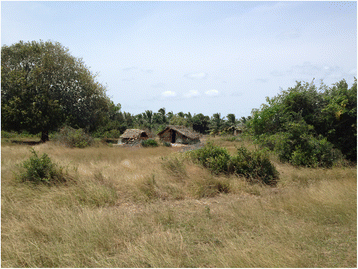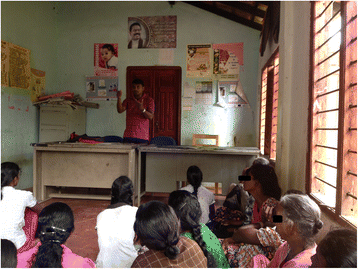Prevention of krait bites by sleeping above ground: preliminary results from an observational pilot study
- PMID: 28352289
- PMCID: PMC5368888
- DOI: 10.1186/s12995-017-0156-7
Prevention of krait bites by sleeping above ground: preliminary results from an observational pilot study
Abstract
Introduction: Neurotoxic envenoming following the bites of kraits (Bungarus spp.) is a common cause of death in the dry zone of Sri Lanka and elsewhere in South Asia. Most of these bites occur at night and are inflicted on people sleeping on the ground. Thus we hypothesized that the simple measure of sleeping above ground would help to reduce the number of observed krait bites.
Methods: This study was conducted in two villages of the Kilinochchi district of Sri Lanka which had reported a high number of krait bites in the two years preceding the study. Most of the residents in these two villages slept on the ground. Residents in one area were given beds free of charge, using funds available from the study. Both villages received health education on the prevention of krait bites.
Results: Forty five beds were distributed to 45 families in one village. This enabled 115 individuals to sleep above ground level. 6 monthly follow up visits were conducted ensuring the proper utilization of beds. Follow up was continued for 30 months (September 2013-March 2016); during this time period no krait bites were reported in either area.
Conclusions: We observed a dramatic decline of krait bites in both villages. Better awareness with effective health education and clearing of vegetation could have led to the decline in the number of krait bites in both villages.
Keywords: Krait bites; Poverty; Prevention; Snakebite; Sri Lanka.
Figures



Similar articles
-
Distinctive epidemiologic and clinical features of common krait (Bungarus caeruleus) bites in Sri Lanka.Am J Trop Med Hyg. 2008 Sep;79(3):458-62. Am J Trop Med Hyg. 2008. PMID: 18784244
-
Confirmed Ceylon krait (Bungarus ceylonicus) envenoming in Sri Lanka resulting in neuromuscular paralysis: a case report.J Med Case Rep. 2017 Nov 24;11(1):330. doi: 10.1186/s13256-017-1503-0. J Med Case Rep. 2017. PMID: 29169382 Free PMC article.
-
Two rare case reports of confirmed Ceylon krait (Bungarus ceylonicus) envenoming in Sri Lanka.Toxicon. 2017 Mar 1;127:44-48. doi: 10.1016/j.toxicon.2017.01.003. Epub 2017 Jan 4. Toxicon. 2017. PMID: 28062164
-
Therapeutic potential of krait venom.Toxicon. 2017 Jun 1;131:48-53. doi: 10.1016/j.toxicon.2017.03.004. Epub 2017 Mar 14. Toxicon. 2017. PMID: 28315357 Review.
-
Long-term Effects of Snake Envenoming.Toxins (Basel). 2019 Mar 31;11(4):193. doi: 10.3390/toxins11040193. Toxins (Basel). 2019. PMID: 30935096 Free PMC article. Review.
Cited by
-
Mortality due to snakebite and other venomous animals in the Indian state of Bihar: Findings from a representative mortality study.PLoS One. 2018 Jun 7;13(6):e0198900. doi: 10.1371/journal.pone.0198900. eCollection 2018. PLoS One. 2018. PMID: 29879197 Free PMC article. Clinical Trial.
-
Perceptions, awareness on snakebite envenoming among the tribal community and health care providers of Dahanu block, Palghar District in Maharashtra, India.PLoS One. 2021 Aug 5;16(8):e0255657. doi: 10.1371/journal.pone.0255657. eCollection 2021. PLoS One. 2021. PMID: 34351997 Free PMC article.
-
Snakebite Envenomation, Attitudes, and Behavior toward Snakes in Banten, Indonesia.Animals (Basel). 2022 Aug 11;12(16):2051. doi: 10.3390/ani12162051. Animals (Basel). 2022. PMID: 36009641 Free PMC article.
-
Promoting co-existence between humans and venomous snakes through increasing the herpetological knowledge base.Toxicon X. 2021 Aug 26;12:100081. doi: 10.1016/j.toxcx.2021.100081. eCollection 2021 Nov. Toxicon X. 2021. PMID: 34522881 Free PMC article.
-
The timing is right to end snakebite deaths in South Asia.BMJ. 2019 Jan 22;364:k5317. doi: 10.1136/bmj.k5317. BMJ. 2019. PMID: 30670457 Free PMC article.
References
-
- Kasturiratne A, Wickremasinghe AR, de Silva N, Gunawardena NK, Pathmeswaran A, Premaratna R, Savioli L, Lalloo DG, de Silva HJ. The global burden of snakebite: a literature analysis and modelling based on regional estimates of envenoming and deaths. PLoS Med. 2008;5(11):e218. doi: 10.1371/journal.pmed.0050218. - DOI - PMC - PubMed
-
- Ediriweera DS, Kasturiratne A, Pathmeswaran A, Gunawardena NK, Wijayawickrama BA, Jayamanne SF, Isbister GK, Dawson A, Giorgi E, Diggle PJ, et al. Mapping the risk of snakebite in Sri Lanka - a national survey with geospatial analysis. PLoS Negl Trop Dis. 2016;10(7):e0004813. doi: 10.1371/journal.pntd.0004813. - DOI - PMC - PubMed
-
- Ariaratnam CA, Sheriff MH, Arambepola C, Theakston RD, Warrell DA. Syndromic approach to treatment of snake bite in Sri Lanka based on results of a prospective national hospital-based survey of patients envenomed by identified snakes. Am J Trop Med Hyg. 2009;81(4):725–731. doi: 10.4269/ajtmh.2009.09-0225. - DOI - PubMed
-
- Ariaratnam CA, Sheriff MH, Theakston RD, Warrell DA. Distinctive epidemiologic and clinical features of common krait (Bungarus caeruleus) bites in Sri Lanka. Am J Trop Med Hyg. 2008;79(3):458–462. - PubMed
Publication types
LinkOut - more resources
Full Text Sources
Other Literature Sources
Miscellaneous

